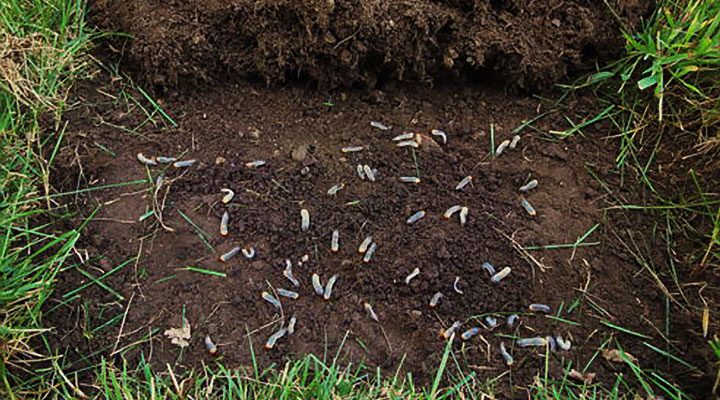
Grubs are the larva of various types of beetles and chafers, such as the Japanese beetle or European chafer. You’re likely concerned about them because of the potential damage they can do to your lawn. While both grubs and adults can cause damage to your lawn and plants, the biggest problem is actually the fact that grubs and chafers are prey for a variety of animals, including moles, skunks, and raccoons. These creatures will tear up your lawn to get to the grubs, quickly turning your grass into a field of potholes.
Before investing time and resources into curtailing your grub problem, double check that the issue actually is grubs! To see if your yard or garden has a grub problem, dig out a section of dirt using a shovel. This should be around 2-inches deep. Parse through the dirt to discover the white, C-shaped grubs. They’re usually under an inch long. Finding one grub doesn’t mean that you need to sound the alarm. Grubs and beetles are part of our natural ecosystem after all. However, if you’re finding an overwhelming amount of grubs in your samples, it’s time to take action.
Nematodes
Nematodes are some of the best biological control agents on the market. They’re effective at eliminating grubs, though they are ineffective against adult beetles. Application of beneficial nematodes is simple. First, make sure that the soil is moist since nematodes require a moist environment. They are applied with the substrate they come in, just mix with water or directly applied to soil (NemaBeads) See this link for more information. Apply the nematodes to the moist soil in the late afternoon. You can use a sprayer or a sprinkler-style watering can to do so. Depending on the severity of the infestation, multiple applications may be needed so continue to monitor for signs of damage and be prepared to reapply if needed.
Milky Spore
While beneficial nematodes are capable of eliminating a wide variety of insect pests, milky spore is a specific, bacteria-based form of pest control. If you’re using milky spore, you’re focused on getting rid of Japanese beetle grubs. The ideal time for soil application is in late July or early August. This is when the grubs are closest to the surface of the soil and feeding on your plant roots. While they’re biting into roots, the grubs will also ingest milky spore bacteria. Once this happens, the bacteria begin to rapidly multiply, killing the grub within 3 weeks. As the grub decomposes, the multiplying bacteria are released back into the soil to infect new grubs.
Milky spore is very harmful to Japanese beetle grubs, but has no effect on various beneficial insects, household pets, or humans.
Due Diligence
Keeping a healthy lawn goes a long way towards eliminating grub infestations and preventing noticeable grub damage. A healthy lawn that receives regular rainfall (or is artificially supplied with water through an irrigation system) will have much stronger roots. Keeping the grass trimmed at 3-4 inches can also strengthen the root system of your grass. Cutting grass below 3 inches can cause root stress, which in turn results in a higher susceptibility to grub damage. Of course, a proper fertilizing routine goes a long way too!
ARBICO Organics was founded in 1979 in Arizona. Over 40 years later, ARBICO Organics continues to produce innovative means of natural biological pest control for a wide range of consumers. Their product line up ranges from environmentally friendly solutions to common garden pests to biological powerhouses used in professional agriculture and at racetracks.


Comment here